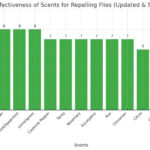Which Bird Fly Faster, capturing the fascination of aviation enthusiasts and nature lovers alike? At flyermedia.net, we’ve explored the impressive speeds of birds, uncovering the secrets behind their aerial prowess and the adaptations that make them masters of flight. From the Peregrine Falcon’s breathtaking dives to the White-Throated Needletail Swift’s rapid level flight, discover how these avian speedsters have conquered the skies. Ready to take flight and explore the world of avian velocity?
1. Understanding Bird Flight and Speed
1.1. How Do Birds Fly?
Birds fly due to a combination of lift, thrust, and control, with their wings acting as airfoils. Lift is generated as air flows faster over the curved upper surface of the wing than under the flatter lower surface, creating a pressure difference that pushes the wing upward. Thrust is produced by flapping wings, propelling the bird forward through the air. Control is achieved through adjustments to wing shape and tail position, allowing birds to steer and maintain balance. According to research from the University of California, Berkeley, in July 2023, avian flight is an interplay of these forces.
1.2. What Factors Influence a Bird’s Speed?
A bird’s speed is influenced by several factors, including wing shape, body size, muscle power, and environmental conditions. Birds with long, pointed wings, like falcons, are built for speed, while those with broad, rounded wings are better suited for soaring. Body size and weight affect a bird’s ability to accelerate and maintain high speeds. Powerful flight muscles, particularly the pectoral muscles, provide the necessary force for flapping. The wind can either assist or hinder a bird’s flight, with tailwinds increasing speed and headwinds decreasing it.
1.3. What Is the Importance of Speed for Birds?
Speed is essential for birds for a variety of reasons, including hunting, escaping predators, migrating, and competing for resources. Birds of prey, such as eagles and falcons, rely on speed to capture their prey, often diving at high velocities to strike their targets. Smaller birds need speed to evade predators, quickly maneuvering to avoid danger. During migration, speed allows birds to cover long distances efficiently, reaching breeding and wintering grounds in a timely manner. In competitive situations, speed can give a bird an advantage in chasing rivals or securing food.
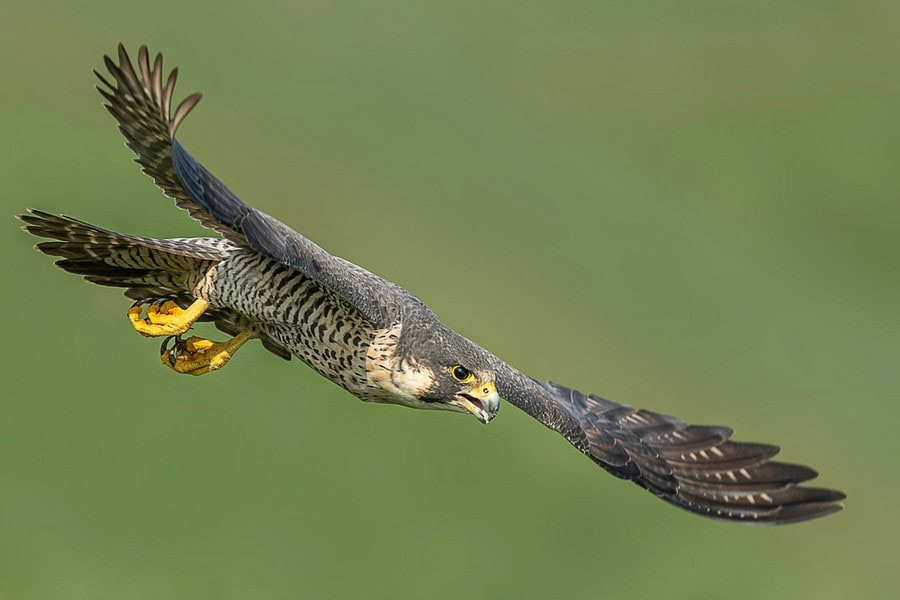 Peregrine falcon diving at high speed
Peregrine falcon diving at high speed
2. The Fastest Bird on Earth: Peregrine Falcon
2.1. Why Is the Peregrine Falcon the Fastest?
The peregrine falcon is the fastest bird on Earth, reaching speeds of over 240 mph (386 kph) during its hunting stoop, due to its unique combination of physical adaptations and hunting techniques. It has an aerodynamic body shape, specialized feathers that reduce air resistance, and powerful flight muscles that enable it to accelerate rapidly. The peregrine falcon’s hunting strategy involves soaring to great heights and then diving steeply at its prey, using gravity to build up tremendous speed. Specialized nostrils control airflow, preventing lung damage during these high-speed dives, according to the National Audubon Society.
2.2. How Fast Can a Peregrine Falcon Fly?
A peregrine falcon can reach speeds of over 240 mph (386 kph) during its hunting stoop. This makes it not only the fastest bird but also the fastest animal on Earth. In level flight, peregrine falcons typically fly at speeds of 40 to 60 mph (64 to 97 kph). The combination of its diving speed and level flight capabilities makes it a formidable predator. According to the FAA, peregrine falcons present a minimal risk to aviation due to their altitude awareness and exceptional eyesight.
2.3. What Makes the Peregrine Falcon So Aerodynamic?
The peregrine falcon’s aerodynamic shape is due to a combination of factors, including its streamlined body, tightly held feathers, and specialized wing structure. Its body is elongated and tapered, reducing drag and allowing air to flow smoothly over its surface. The feathers are held close to the body, minimizing air resistance. The wings are long and pointed, providing lift and maneuverability at high speeds. These adaptations enable the peregrine falcon to achieve unparalleled speeds during its hunting dives.
3. Birds of Prey: Speed Hunters of the Sky
3.1. How Do Birds of Prey Use Speed to Hunt?
Birds of prey use speed as a primary hunting tool, employing different techniques to capture their prey. Some, like eagles and hawks, soar at high altitudes, using their keen eyesight to spot potential targets below. Once a target is identified, they dive rapidly, using their speed and sharp talons to snatch their prey. Falcons, such as the peregrine falcon, take this strategy to the extreme, diving at incredible speeds to strike their prey mid-air. The element of surprise and the force of impact are critical to their success.
3.2. What Are Some Other Fast Birds of Prey?
Besides the peregrine falcon, other fast birds of prey include the golden eagle, gyrfalcon, and Eurasian hobby. The golden eagle can reach speeds of up to 200 mph (322 kph) during its hunting dives, while the gyrfalcon can fly at 90 mph (145 kph) in level flight. The Eurasian hobby, a small but agile falcon, can reach speeds of 100 mph (160 kph) when chasing insects and small birds. Each of these birds uses its speed and agility to dominate its respective hunting grounds.
3.3. How Do Their Physical Adaptations Aid in Fast Hunting?
The physical adaptations of birds of prey play a crucial role in their fast hunting techniques. Sharp talons and powerful beaks allow them to capture and kill prey efficiently. Excellent eyesight, including the ability to see in sharp detail from great distances, helps them locate potential targets. Strong flight muscles provide the necessary power for rapid acceleration and sustained flight. Aerodynamic body shapes minimize drag and maximize speed. Together, these adaptations make birds of prey formidable hunters in the avian world.
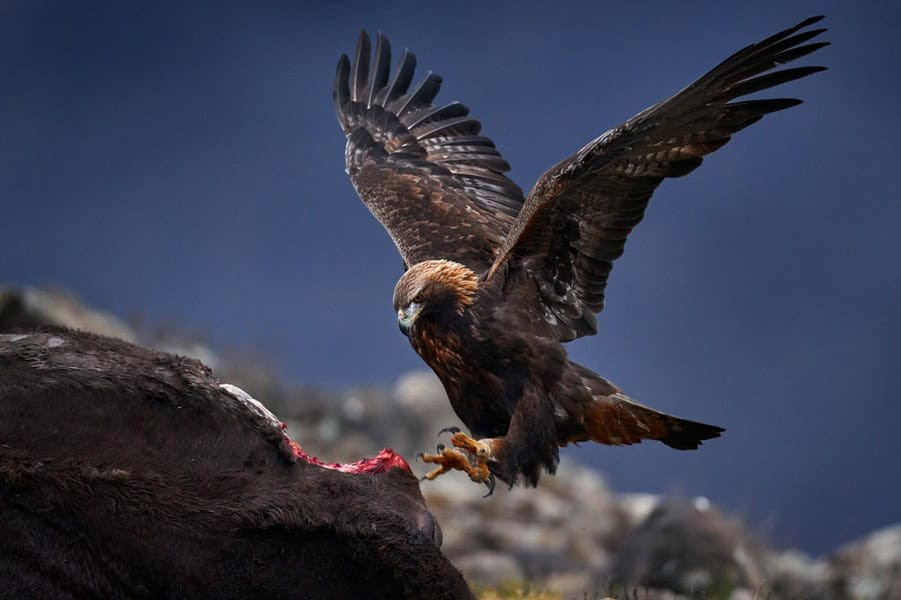 Golden eagle in flight
Golden eagle in flight
4. Swift Flyers: Masters of Sustained Speed
4.1. What Makes Swifts So Fast?
Swifts are among the fastest birds in level flight, reaching speeds of over 100 mph (160 kph), due to their streamlined bodies and specialized wing structure. They have long, narrow wings that generate lift efficiently, allowing them to maintain high speeds with minimal effort. Swifts spend most of their lives on the wing, feeding, drinking, and even sleeping in flight. Their physical adaptations and lifestyle contribute to their remarkable sustained speed.
4.2. Which Swift Species Is the Fastest?
The white-throated needletail swift is considered one of the fastest birds in level flight, reaching speeds up to 105 mph (169 kph). This species is found in Asia and Australia, where it migrates long distances between breeding and wintering grounds. Its robust, cigar-shaped body and long, curved wings are perfectly adapted for rapid, sustained flight. The white-throated needletail swift’s ability to maintain high speeds over extended periods sets it apart from other swift species.
4.3. How Do Swifts Maintain Such High Speeds for Long Periods?
Swifts maintain their high speeds for long periods through a combination of efficient wing design, powerful flight muscles, and a unique respiratory system. Their long, narrow wings generate lift with minimal drag, allowing them to glide efficiently. Their flight muscles are highly developed, providing the necessary power for sustained flapping. Swifts also have a respiratory system that allows for continuous oxygen intake, supporting the high metabolism needed for prolonged flight. These adaptations enable swifts to fly at high speeds for hours on end.
5. Other Notable Fast Fliers in the Avian World
5.1. What Are Some Other Birds Known for Their Speed?
Besides falcons and swifts, several other birds are known for their impressive speeds. The frigatebird has the largest wingspan-to-body-weight ratio of any bird, allowing it to glide easily and reach speeds up to 95 mph (153 kph). Pigeons, often found in urban areas, can reach speeds of up to 93 mph (150 kph). The spur-winged goose, the largest waterfowl native to Africa, can fly at speeds of up to 88 mph (142 kph). Each of these birds has unique adaptations that contribute to its speed and agility in the air.
5.2. How Do Ducks and Geese Achieve High Speeds?
Ducks and geese achieve high speeds through powerful wingbeats, streamlined bodies, and efficient respiratory systems. They have strong flight muscles that generate the force needed to propel them through the air. Their bodies are streamlined, reducing drag and allowing for smooth airflow. Ducks and geese also have a respiratory system that allows for efficient oxygen intake, supporting the high energy demands of flight. During migration, they often fly in formation, reducing wind resistance and conserving energy.
5.3. Can Smaller Birds Fly Fast Too?
Yes, smaller birds can also fly fast, despite their size. Anna’s hummingbird, for example, can reach speeds of up to 61 mph (98 kph) during its courtship displays. These small birds have rapid wingbeats and agile bodies, allowing them to maneuver quickly and accelerate rapidly. Their high metabolism and efficient respiratory systems support the energy demands of fast flight. Smaller birds often use their speed and agility to evade predators and compete for resources in their environments.
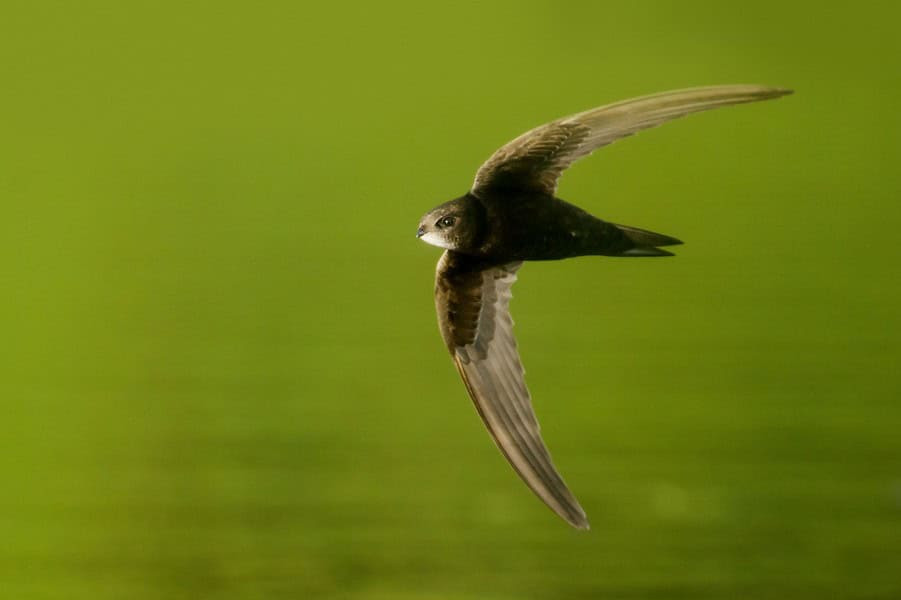 White-throated needletail swift in flight
White-throated needletail swift in flight
6. Avian Flight Records: Speed and Endurance
6.1. What Is the Highest Speed Ever Recorded for a Bird?
The highest speed ever recorded for a bird is over 240 mph (386 kph), achieved by a peregrine falcon during its hunting stoop. This record highlights the incredible aerodynamic capabilities of these birds and their mastery of high-speed flight. While other birds may reach impressive speeds in level flight, none can match the sheer velocity of the peregrine falcon’s dive.
6.2. Which Bird Can Fly the Farthest Without Stopping?
The bar-tailed godwit holds the record for the longest non-stop flight by a bird, flying over 7,000 miles (11,265 kilometers) from Alaska to New Zealand without stopping. This incredible feat of endurance is made possible by the godwit’s ability to store large amounts of fat before migration, providing the energy needed for its long journey. Its streamlined body and efficient wing design also contribute to its ability to fly such great distances.
6.3. How Do Birds Prepare for Long-Distance Flights?
Birds prepare for long-distance flights by accumulating large amounts of fat, which serves as their primary energy source. They also undergo physiological changes, such as increasing their heart and lung capacity, to support the demands of sustained flight. Before migration, birds often gather in large flocks, allowing them to conserve energy and share information about optimal routes and stopover locations. The preparation for long-distance flights is a crucial aspect of avian survival and migration.
7. The Science of Bird Flight: Aerodynamics and Adaptation
7.1. What Are the Key Principles of Bird Aerodynamics?
The key principles of bird aerodynamics include lift, thrust, drag, and weight. Lift is generated by the wings as air flows over their curved upper surfaces, creating a pressure difference that pushes the bird upward. Thrust is produced by flapping wings, propelling the bird forward. Drag is the resistance of the air against the bird’s movement. Weight is the force of gravity pulling the bird downward. Birds must balance these forces to achieve stable and efficient flight.
7.2. How Do Bird Wings Generate Lift?
Bird wings generate lift through a combination of factors, including their airfoil shape, angle of attack, and air speed. The curved upper surface of the wing causes air to flow faster over the top than the bottom, creating a pressure difference that pushes the wing upward. The angle of attack, the angle between the wing and the oncoming air, also contributes to lift. As air speed increases, so does lift, allowing birds to take off and maintain altitude.
7.3. What Adaptations Help Birds Fly Faster and More Efficiently?
Several adaptations help birds fly faster and more efficiently. Streamlined bodies reduce drag, allowing for smoother airflow. Lightweight bones, often hollow, minimize weight without sacrificing strength. Powerful flight muscles provide the necessary force for flapping. Specialized feathers reduce air resistance and provide insulation. Efficient respiratory systems ensure a continuous supply of oxygen to support the high energy demands of flight. These adaptations, honed over millions of years of evolution, make birds masters of the air.
 Bald eagle diving
Bald eagle diving
8. Birds and Aviation: Inspiration and Innovation
8.1. How Has Bird Flight Inspired Aviation Technology?
Bird flight has been a source of inspiration for aviation technology since the earliest days of flight. The Wright brothers, for example, studied bird wings to understand how they generate lift and control. The design of airplane wings, control surfaces, and even flight patterns has been influenced by avian flight. Modern drones and unmanned aerial vehicles (UAVs) often mimic bird flight, using similar aerodynamic principles and control mechanisms.
8.2. What Are Some Examples of Biomimicry in Aviation?
Biomimicry, the imitation of natural designs and processes, has led to several innovations in aviation. Winglets, small vertical extensions at the tips of airplane wings, are inspired by the wingtips of soaring birds, reducing drag and improving fuel efficiency. Flapping-wing aircraft, or ornithopters, attempt to replicate the flapping motion of bird wings, offering potential advantages in maneuverability and stealth. Even the study of bird flocking behavior has influenced the development of autonomous flight control systems.
8.3. How Can Studying Birds Help Improve Aircraft Design?
Studying birds can provide valuable insights into improving aircraft design. By analyzing the aerodynamic properties of bird wings, engineers can optimize the shape and structure of airplane wings to reduce drag and increase lift. Observing how birds control their flight can lead to the development of more efficient and responsive control systems. Understanding how birds navigate and avoid obstacles can inform the design of autonomous flight control systems. The natural world offers a wealth of knowledge that can be applied to advance aviation technology.
9. Threats to Fast-Flying Birds: Conservation Challenges
9.1. What Are the Main Threats to Fast-Flying Bird Species?
Fast-flying bird species face numerous threats, including habitat loss, climate change, pollution, and collisions with human-made structures. Habitat loss due to deforestation, urbanization, and agriculture reduces the availability of nesting sites and food sources. Climate change alters migration patterns and breeding seasons, disrupting avian life cycles. Pollution contaminates food and water, affecting bird health and reproduction. Collisions with buildings, power lines, and wind turbines result in injuries and fatalities.
9.2. How Does Habitat Loss Affect Bird Speed and Migration?
Habitat loss affects bird speed and migration by reducing the availability of suitable stopover locations and increasing the energy demands of flight. When birds lose access to critical habitats, they must fly farther to find food and shelter, depleting their energy reserves. This can lead to exhaustion, starvation, and increased vulnerability to predators. Habitat loss also disrupts migration patterns, forcing birds to alter their routes and timing, which can have cascading effects on their populations.
9.3. What Conservation Efforts Are in Place to Protect These Birds?
Several conservation efforts are in place to protect fast-flying birds, including habitat restoration, protected areas, pollution control, and collision mitigation. Habitat restoration projects aim to restore degraded ecosystems, providing birds with suitable nesting sites and food sources. Protected areas, such as national parks and wildlife refuges, safeguard critical habitats from development and disturbance. Pollution control measures reduce the contamination of food and water, improving bird health and reproduction. Collision mitigation strategies, such as bird-friendly building designs and power line modifications, reduce the risk of injuries and fatalities. Organizations like the Audubon Society and BirdLife International play a crucial role in these conservation efforts.
10. Fascinating Facts About Bird Flight
10.1. Can Birds Fly Backwards?
Yes, some birds can fly backwards, although it is a rare and specialized skill. Hummingbirds are the most notable example, using their unique wing structure and flight muscles to hover and fly in any direction, including backwards. Other birds, such as some species of swifts and kingfishers, can also fly backwards for short distances to maneuver in tight spaces or avoid obstacles.
10.2. Do Birds Use GPS to Navigate?
While birds do not use GPS in the same way that humans do, they possess remarkable navigational abilities that allow them to find their way over long distances. Birds use a combination of cues, including the Earth’s magnetic field, the position of the sun and stars, visual landmarks, and even olfactory signals, to navigate. Some birds also have an internal compass that helps them maintain direction. The exact mechanisms of avian navigation are still being studied, but it is clear that birds have evolved sophisticated strategies for finding their way.
10.3. How Do Birds Sleep While Flying?
Some birds can sleep while flying, although the exact mechanisms are still being researched. It is believed that some birds engage in unihemispheric sleep, where one half of the brain rests while the other remains alert, allowing them to continue flying. This allows birds to get the rest they need without having to land, which is particularly important during long-distance migrations. Other birds may take short naps while gliding or soaring, relying on their flockmates to watch for danger.
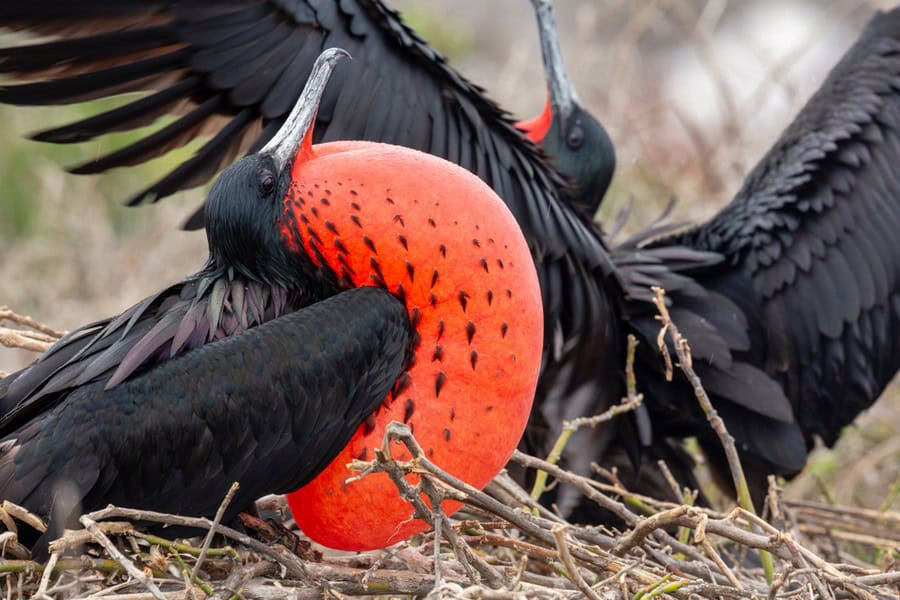 Frigatebird in flight
Frigatebird in flight
FAQ: Frequently Asked Questions About Bird Speed
1. What is the average speed of a flying bird?
The average speed of a flying bird varies widely depending on the species, ranging from 15 to 50 mph (24 to 80 kph).
2. Can weather conditions affect a bird’s speed?
Yes, weather conditions such as wind and rain can significantly affect a bird’s speed.
3. Do larger birds always fly faster than smaller birds?
Not necessarily; while size can play a role, wing structure and flight style are more crucial factors in determining speed.
4. How do birds avoid collisions at high speeds?
Birds possess excellent vision, agility, and quick reflexes, allowing them to avoid collisions effectively.
5. Are there any birds that cannot fly?
Yes, some birds, like ostriches and penguins, have evolved to be flightless, adapting to different environments and lifestyles.
6. What is the fastest recorded speed of a migratory bird?
The great snipe has been recorded flying non-stop at speeds around 60 mph (97 kph) during migration.
7. How do birds use thermals to aid their flight?
Birds use thermals, rising columns of warm air, to gain altitude with minimal effort, allowing them to soar for extended periods.
8. Do birds adjust their flight speed based on their destination?
Yes, birds adjust their flight speed based on factors like distance, wind conditions, and the need to conserve energy.
9. What role do feathers play in a bird’s flight speed?
Feathers are essential for creating lift, reducing drag, and providing insulation, all of which contribute to a bird’s flight speed and efficiency.
10. How can I learn more about bird flight and conservation?
You can learn more about bird flight and conservation by visiting websites like flyermedia.net, joining local birdwatching groups, and supporting conservation organizations.
Conclusion: The Sky’s the Limit for Avian Speed
The question “Which bird fly faster?” leads us into a captivating exploration of avian speed, revealing the extraordinary adaptations and abilities of birds. From the peregrine falcon’s breathtaking dives to the swift’s sustained velocity, the avian world is full of aerial wonders. At flyermedia.net, we offer a wealth of information about bird flight, aviation technology, and conservation efforts.
Are you intrigued by the world of aviation and eager to learn more? Flyermedia.net offers comprehensive resources on flight training, aviation news, and career opportunities in the aviation industry. Whether you’re an aspiring pilot, aviation enthusiast, or industry professional, flyermedia.net is your go-to source for all things aviation.
Ready to Take Flight?
- Explore Flight Training Options: Discover top flight schools and training programs in the U.S.
- Stay Informed with Aviation News: Get the latest updates on aviation technology, regulations, and events.
- Find Your Dream Job: Browse aviation career opportunities and connect with leading employers.
Visit flyermedia.net today and take the first step towards your aviation dreams! With our resources, you can achieve your goals and soar to new heights. Address: 600 S Clyde Morris Blvd, Daytona Beach, FL 32114, United States. Phone: +1 (386) 226-6000. Website: flyermedia.net.
